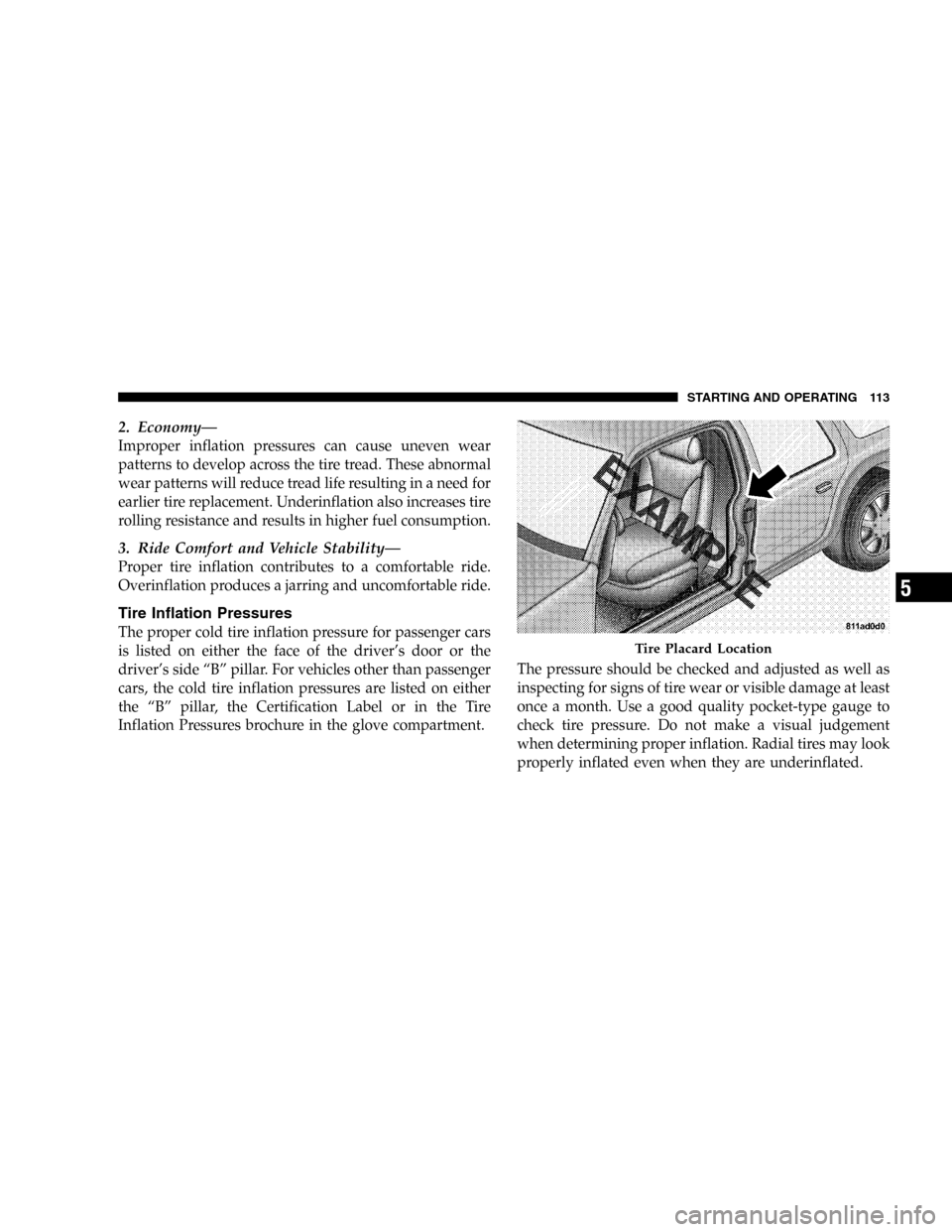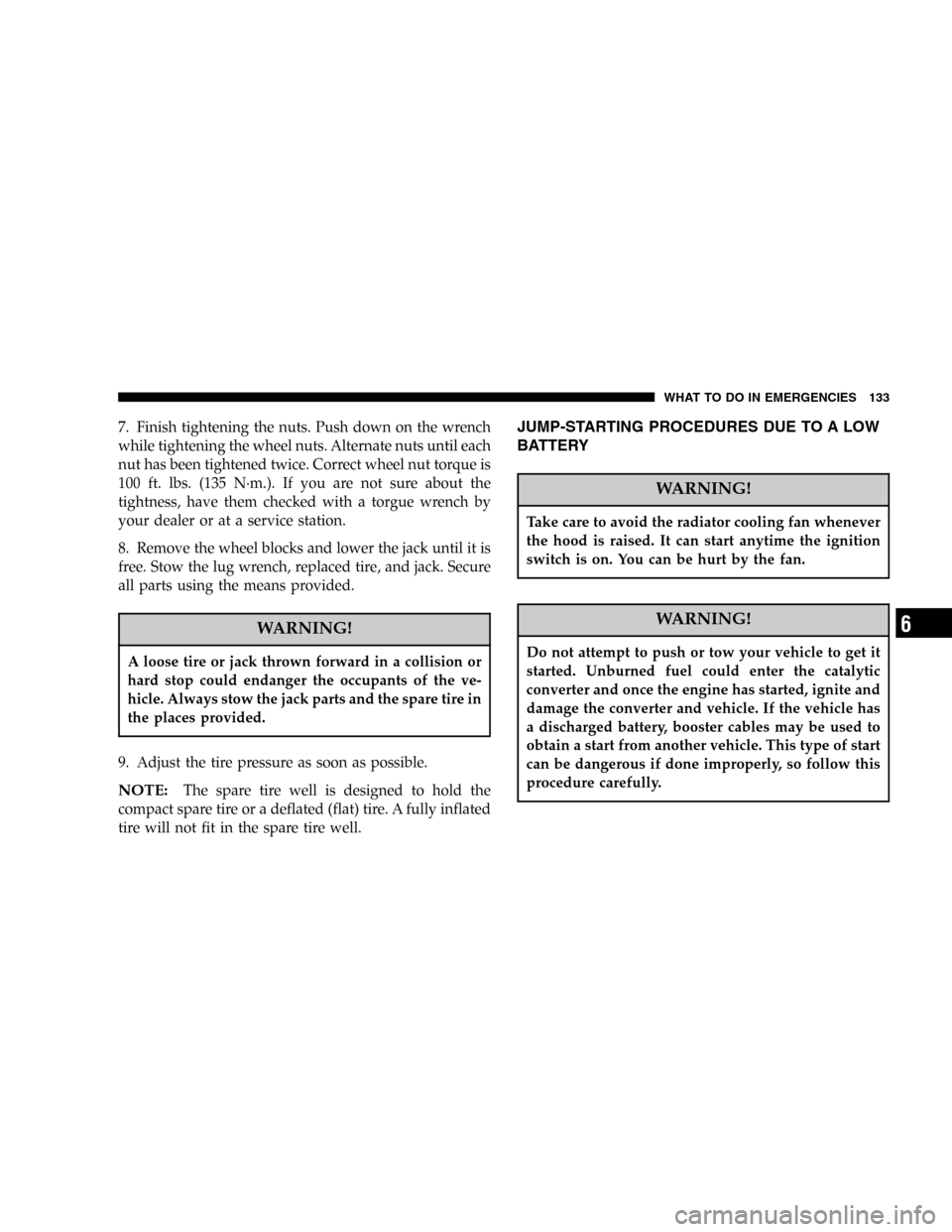fuel pressure DODGE NEON SRT 2005 2.G Owners Manual
[x] Cancel search | Manufacturer: DODGE, Model Year: 2005, Model line: NEON SRT, Model: DODGE NEON SRT 2005 2.GPages: 216, PDF Size: 7.18 MB
Page 46 of 216

Safety Checks You Should Make Inside The
Vehicle
Seat Belts
Inspect the belt system periodically, checking for cuts,
frays and loose parts. Damaged parts must be replaced
immediately. Do not disassemble or modify the system.
Front seat belt assemblies must be replaced after a
collision. Rear seat belt assemblies must be replaced after
a collision if they have been damaged (bent retractor, torn
webbing, etc.). If there is any question regarding belt or
retractor condition, replace the belt.
Airbag Light
The light should come on and remain on for 6 to
8 seconds as a bulb check when the ignition
switch is first turned to ON/RUN. If the bulb is
not lit during starting, have it replaced. If the light stays
on or comes on while driving, have the system checked
by an authorized dealer.
Defrosters
Check operation by selecting the defrost mode and place
the blower control on high speed. You should be able to
feel the air directed against the windshield.
Periodic Safety Checks You Should Make Outside
The Vehicle
Tires
Examine tires for excessive tread wear or uneven wear
patterns. Check for stones, nails, glass, or other objects
lodged in the tread. Inspect for tread cuts or sidewall
cracks. Check wheel nuts for tightness, and tires (includ-
ing spare) for proper pressure.
Lights
Have someone observe the operation of exterior lights
while you work the controls. Check turn signal and high
beam indicator lights on the instrument panel.
Fluid Leaks
Check area under vehicle after overnight parking for fuel,
water, oil, or other fluid leaks. Also, if gasoline fumes are
present, the cause should be corrected immediately.
46 THINGS TO KNOW BEFORE STARTING YOUR VEHICLE
Page 91 of 216

TURBO BOOST GAUGE
Your vehicle is equipped with a boost gauge that indi-
cates the intake manifold pressure relative to barometric
pressure. The engine management system in your vehicle
intelligently regulates intake manifold pressure based on
environmental (ambient) and engine operating condi-
tions. With the accelerator pedal fully depressed, it is
normal for the maximum intake manifold pressure
(boost) to vary from 11 to 15 psi.If low octane fuel (below the recommended 91 octane
(R+M)/2)) is used, boost will be reduced significantly.
Normal boost levels will return once the recommended
fuel is used and the engine controller adapts to the fuel
octane level.
Turbo Boost Gauge
UNDERSTANDING YOUR INSTRUMENT PANEL 91
4
Page 113 of 216

2. Economy—
Improper inflation pressures can cause uneven wear
patterns to develop across the tire tread. These abnormal
wear patterns will reduce tread life resulting in a need for
earlier tire replacement. Underinflation also increases tire
rolling resistance and results in higher fuel consumption.
3. Ride Comfort and Vehicle Stability—
Proper tire inflation contributes to a comfortable ride.
Overinflation produces a jarring and uncomfortable ride.
Tire Inflation Pressures
The proper cold tire inflation pressure for passenger cars
is listed on either the face of the driver’s door or the
driver’s side“B”pillar. For vehicles other than passenger
cars, the cold tire inflation pressures are listed on either
the“B”pillar, the Certification Label or in the Tire
Inflation Pressures brochure in the glove compartment.The pressure should be checked and adjusted as well as
inspecting for signs of tire wear or visible damage at least
once a month. Use a good quality pocket-type gauge to
check tire pressure. Do not make a visual judgement
when determining proper inflation. Radial tires may look
properly inflated even when they are underinflated.
Tire Placard Location
STARTING AND OPERATING 113
5
Page 133 of 216

7. Finish tightening the nuts. Push down on the wrench
while tightening the wheel nuts. Alternate nuts until each
nut has been tightened twice. Correct wheel nut torque is
100 ft. lbs. (135 N·m.). If you are not sure about the
tightness, have them checked with a torgue wrench by
your dealer or at a service station.
8. Remove the wheel blocks and lower the jack until it is
free. Stow the lug wrench, replaced tire, and jack. Secure
all parts using the means provided.
WARNING!
A loose tire or jack thrown forward in a collision or
hard stop could endanger the occupants of the ve-
hicle. Always stow the jack parts and the spare tire in
the places provided.
9. Adjust the tire pressure as soon as possible.
NOTE:The spare tire well is designed to hold the
compact spare tire or a deflated (flat) tire. A fully inflated
tire will not fit in the spare tire well.
JUMP-STARTING PROCEDURES DUE TO A LOW
BATTERY
WARNING!
Take care to avoid the radiator cooling fan whenever
the hood is raised. It can start anytime the ignition
switch is on. You can be hurt by the fan.
WARNING!
Do not attempt to push or tow your vehicle to get it
started. Unburned fuel could enter the catalytic
converter and once the engine has started, ignite and
damage the converter and vehicle. If the vehicle has
a discharged battery, booster cables may be used to
obtain a start from another vehicle. This type of start
can be dangerous if done improperly, so follow this
procedure carefully.
WHAT TO DO IN EMERGENCIES 133
6
Page 173 of 216

VEHICLE STORAGE
If you will not be using your vehicle for more than 21
days you may want to take steps to preserve your battery.
You may:
•Disengage the mini fuse in the Power Distribution
Center labeled IOD (Ignition Off-Draw).
•Or, disconnect the negative cable from the battery.
REPLACEMENT BULBS
LIGHT BULBS—Inside Bulb No.
ABS Indicator.......................... LED
Airbag Indicator........................ LED
Brake System Warning Indicator............. LED
Climate Controls........................ LED
Console Gear Selector...................PC194
Dome Light............................T579
Glove Box............................PC194
Front Fog Indicator...................... LED
High Beam Indicator....................PC194
Instrument Cluster Illumination............PC194
Low Fuel Indicator....................... LEDLow Oil Pressure Indicator................. LED
Rear Cargo............................T906
Seat Belt Indicator....................... LED
Security Alarm Indicator................... LED
Malfunction Indicator Light................ LED
TRAC OFF Indicator..................... LED
Turn Signal Indicator....................PC194
Voltage Indicator........................ LED
All the inside bulbs are brass or glass wedge base.
Aluminum base bulbs are not approved and should not
be used for replacement.
LIGHTS BULBS—Outside Bulb No.
Headlight.............................9007
Front Park/Turn Signal Light.............3457AK
Front Side Marker Light.................... 168
Front Fog Light......................9145/H10
Center High Mounted Stop Light
(CHMSL).........................921–W16W
Rear Tail/Stop/Turn Signal Light......3157–P27/7W
Backup Light......................921–W16W
License Light........................... 168
MAINTAINING YOUR VEHICLE 173
7
Page 204 of 216

ABS (Anti-Lock Brake) System............. 102
Adding Engine Coolant (Antifreeze)......... 159
Adding Fuel.......................... 124
Air Cleaner, Engine (Engine Air Cleaner Filter) . 151
Air Conditioner Maintenance.............. 153
Air Conditioning........................ 84
Air Conditioning Controls................. 84
Air Conditioning Refrigerant...........153,154
Air Conditioning System................. 153
Air Pressure, Tires...................... 113
Airbag................................ 30
Airbag Deployment...................... 35
Airbag Light.......................38,46,71
Airbag Maintenance...................... 37
Airbag, Side........................... 36
Alarm, Panic........................... 19
Alarm System........................21,71
Alignment and Balance.................. 118
Alterations/Modifications, Vehicle............ 6
Antenna, Satellite Radio................... 83
Antifreeze (Engine Coolant).........158,176,177
Capacities........................... 176
Anti-Lock Brake System (ABS)............. 102Anti-Lock Warning Light.................. 69
Anti-Theft Security Alarm................. 21
Appearance Care....................... 165
Arming Theft System..................... 21
Ashtrays and Lighter..................... 63
Automatic Door Locks.................... 15
Ball Joints............................ 154
Battery............................... 152
Keyless Transmitter Replacement.......... 20
Belts, Drive........................... 149
Belts, Engine.......................... 150
Body Mechanism Lubrication.............. 155
B-Pillar Location....................... 108
Brake Fluid........................... 177
Brake, Parking......................... 100
Brake System.......................102,162
Anti-Lock........................... 102
Hoses.............................. 162
Master Cylinder...................... 163
Parking............................ 100
Warning Light........................ 69
Brakes............................102,162
204 INDEX
Page 205 of 216

Break-In Recommendations, New Vehicle...... 45
Bulb Replacement...................173,174
Capacities, Antifreeze (Engine Coolant)...... 176
Capacities, Fluid....................... 176
Caps, Filler
Fuel............................... 124
Oil (Engine)......................... 148
Carbon Monoxide Warning............... 123
Catalytic Converter..................... 149
CD Changer........................... 79
CD Player...........................75,77
CD Player Maintenance................... 83
Center High Mounted Stop Light........... 176
Central Door Locks...................... 14
Central Locking......................... 14
Chains, Tire........................... 119
Changing A Flat Tire.................... 130
Charging System Light................... 71
Chart, Tire Sizing....................... 105
Child Restraint......................... 38
Child Safety Locks....................... 16
Circuit Breakers.....................170,171Cleaning
Glass.............................. 168
Headlights.......................... 168
Climate Control......................... 84
Clock................................. 74
Compact Disc Maintenance................ 83
Compact Spare Tire..................... 115
Console............................... 62
Contract, Service....................... 198
Cool Down, Turbo....................... 97
Coolant...........................176,177
Cooling System........................ 157
Adding Coolant (Antifreeze)............. 159
Coolant Level.....................157,160
Disposal of Used Coolant............... 159
Drain, Flush, and Refill................. 158
Inspection........................... 160
Points to Remember................159,161
Pressure Cap........................ 159
Rubber and Plastic Components.......... 161
Selection of Coolant................... 158
Corrosion Protection.................... 165
Crankcase Emission Control System......... 151
INDEX 205
10